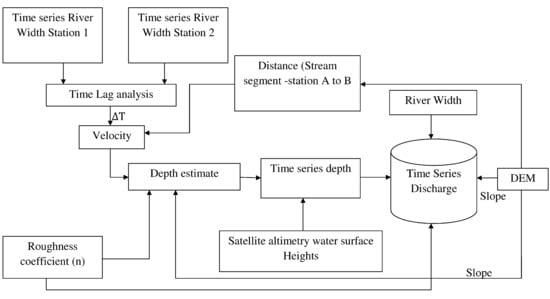Estimation of River Discharge Solely from Remote-Sensing Derived Data: An Initial Study Over the Yangtze River
Abstract
1. Introduction
2. Materials and Methods
2.1. Estimate of River Velocity Using Temporal River Width
2.2. Estimates of the Roughness Coefficient
2.3. Formulation
2.4. Flowchart
- (1)
- The time series river width measurements for 2003, 2004, 2007, and 2008 taken at an upstream and downstream locations were derived using MODIS (MOD09GQ) (Figure 5). Most of the images for 2005 and 2006 were affected by clouds and therefore data for these years were not used.
- (2)
- The ensemble mean of individual river width measurements was determined over a reach length of approximately 1 km at each site. The ensemble mean reduces the measurement error and localized variability [38].
- (3)
- A lag analysis was then carried out to estimate the time lag of the river width changes between station A and station B. A time lag is the time interval for the peak river width measurement observed at station A to be recorded at station B. The peak river width used in this case is the average of the daily river width measurements.
- (4)
- Using the time lag and the distance separation between stations A and B, the average river velocity (assuming a uniform velocity) was estimated.
- (5)
- The roughness coefficient (n) was then estimated using Equation (4) as described in Section 2.2. Equation (12) was then used to estimate the river depth for each river segment.
- (6)
- The estimated water depth was adjusted using the time series stage data derived from satellite altimetry to obtain the time series river depth (Figure 6).
- (7)
- The depth estimates at the virtual stations were compared to the depths computed using the in situ ground discharge data. The depth comparison is meant to establish whether the estimated values are within the range of the values obtained at the ground observation stations. However, it is not an accurate validation of the estimated depths at the virtual station. In order to compute the river depths at the in situ ground stations, the following key steps were used: using datasets derived from river sounding, the river cross-sections were plotted. Then the time series river depth for the period 2003–2008 were taken using a floating GPS device. The cross-sectional areas were computed by fitting the cross-sections by two regular figures, a triangle and a trapezium, separated by a baseline (Figure 7).
- (8)
- Landsat images were used to measure the river width and were employed at the last stage with other estimates for time series river depth, slope, and roughness coefficient to estimate river discharge (Equation (9)). To obtain a reliable slope, the slope values were averaged over a long river reach [36]. For the lower Yangtze River, the standard error of the slope average values from the SRTM DEM (represented as σ in Equation (9) was ±1.3 m. Using a simple relationship equation developed by LeFavour and Alsdorf [36], the appropriate reach length (RL) was determined as follows:where is the minimum slope, for which a value of 0.5 × 105 was adopted as indicated by [39].
- (9)
- The discharge estimates at virtual station 1 and virtual station 2 were validated using the closest ground stations at Hankou (located approximately 43 km from the virtual station (1) and Datong (located approximately 85 km from the virtual station (2) respectively. There are no tributaries in these sections, therefore the discharge at the ground stations and virtual stations were assumed to be the same.
2.5. Performance Evaluation
3. Results
3.1. Estimation of Hydraulic Parameters
3.2. Estimation of the Time Series River Discharge
4. Discussion
4.1. Estimation of Hydraulic Parameters
- (1)
- The accuracy with which the river velocity is estimated. In our methodology, we assume a uniform river flow, which simplifies the variations in river velocity at each point along the river.
- (2)
- The criteria and accuracy with which the roughness coefficient values are assigned or computed.
- (3)
- Finally, the slope of the river affects the accuracy of the height estimate. In a typical natural course, the slope varies from one point to another which limits the potential of estimating the slope from space. Nevertheless, average river slope can be estimated with the assumption of a uniform slope for a chosen river reach.
4.2. Estimation of the Time Series River Discharge
5. Conclusions
Author Contributions
Funding
Acknowledgments
Conflicts of Interest
References
- Brakenridge, G.R.; Cohen, S.; Kettner, A.J.; De Groeve, T.; Nghiem, S.V.; Syvitski, J.P.M.; Fekete, B.M. Calibration of satellite measurements of river discharge using a global hydrology model. J. Hydrol. 2012, 475, 123–136. [Google Scholar] [CrossRef]
- Calmant, S.; Seyler, F. Continental surface waters from satellite altimetry. C. R. Geosci. 2006, 338, 1113–1122. [Google Scholar] [CrossRef]
- Sichangi, A.W.; Wang, L.; Yang, K.; Chen, D.; Wang, Z.; Li, X.; Zhou, J.; Liu, W.; Kuria, D. Estimating continental river basin discharges using multiple remote sensing data sets. Remote Sens. Environ. 2016, 179, 36–53. [Google Scholar] [CrossRef]
- Brakenridge, G.R.; Nghiem, S.V.; Anderson, E.; Mic, R. Orbital microwave measurement of river discharge and ice status. Water Resour. Res. 2007, 43. [Google Scholar] [CrossRef]
- Tarpanelli, A.; Barbetta, S.; Brocca, L.; Moramarco, T. River discharge estimation by using altimetry data and simplified flood routing modeling. Remote Sens. 2013, 5, 4145–4163. [Google Scholar] [CrossRef]
- Gleason, C.J.; Smith, L.C.; Lee, J. Retrieval of river discharge solely from satellite imagery and at-many-stations hydraulic geometry: Sensitivity to river form and optimization parameters. Water Resour. Res. 2014, 50, 9604–9619. [Google Scholar] [CrossRef]
- Gleason, C.J.; Smith, L.C. Toward global mapping of river discharge using satellite images and at-many-stations hydraulic geometry. Proc. Natl. Acad. Sci. USA 2014, 111, 4788–4791. [Google Scholar] [CrossRef] [PubMed]
- Pan, F.; Wang, C.; Xi, X. Constructing river stage-discharge rating curves using remotely sensed river cross-sectional inundation areas and river bathymetry. J. Hydrol. 2016, 540, 670–687. [Google Scholar] [CrossRef]
- Mersel, M.K.; Smith, L.C.; Andreadis, K.M.; Durand, M.T. Estimation of river depth from remotely sensed hydraulic relationships. Water Resour. Res. 2013, 49, 3165–3179. [Google Scholar] [CrossRef]
- Smith, L.C.; Isacks, B.L.; Bloom, A.L.; Murray, A.B. Estimation of discharge from three braided rivers using synthetic aperture radar satellite imagery: Potential application to ungaged basins. Water Resour. Res. 1996, 32, 2021–2034. [Google Scholar] [CrossRef]
- Pavelsky, T.M. Using width-based rating curves from spatially discontinuous satellite imagery to monitor river discharge. Hydrol. Process. 2014, 28, 3035–3040. [Google Scholar] [CrossRef]
- Smith, L.C.; Pavelsky, T.M. Estimation of river discharge, propagation speed, and hydraulic geometry from space: Lena River, Siberia. Water Resour. Res. 2008, 44. [Google Scholar] [CrossRef]
- Papa, F.; Bala, S.K.; Pandey, R.K.; Durand, F.; Gopalakrishna, V.V.; Rahman, A.; Rossow, W.B. Ganga-Brahmaputra river discharge from jason-2 radar altimetry: An update to the long-term satellite-derived estimates of continental freshwater forcing flux into the Bay of Bengal. J. Geophys. Res. Ocean. 2012, 117, C11021. [Google Scholar] [CrossRef]
- Birkinshaw, S.J.; O’Donnell, G.M.; Moore, P.; Kilsby, C.G.; Fowler, H.J.; Berry, P.A.M. Using satellite altimetry data to augment flow estimation techniques on the mekong river. Hydrol. Process. 2010, 24, 3811–3825. [Google Scholar] [CrossRef]
- Leopold, L.B.; Maddock, T. The Hydraulic Geometry of Stream Channels and Some Physiographic Implications; Geological Survey Professional Paper 252; US Government Printing Office: Washington, DC, USA, 1953; 57p.
- Sun, W.; Ishidaira, H.; Bastola, S. Calibration of hydrological models in ungauged basins based on satellite radar altimetry observations of river water level. Hydrol. Process. 2012, 26, 3524–3537. [Google Scholar] [CrossRef]
- Sun, W.; Ishidaira, H.; Bastola, S. Prospects for calibrating rainfall-runoff models using satellite observations of river hydraulic variables as surrogates for in situ river discharge measurements. Hydrol. Process. 2012, 26, 872–882. [Google Scholar] [CrossRef]
- Javaheri, A.; Nabatian, M.; Omranian, E.; Babbar-Sebens, M.; Noh, S. Merging real-time channel sensor networks with continental-scale hydrologic models: A data assimilation approach for improving accuracy in flood depth predictions. Hydrology 2018, 5, 9. [Google Scholar] [CrossRef]
- Bjerklie, D.M.; Dingman, S.L.; Vorosmarty, C.J.; Bolster, C.H.; Congalton, R.G. Evaluating the potential for measuring river discharge from space. J. Hydrol. 2003, 278, 17–38. [Google Scholar] [CrossRef]
- Elmi, O.; Tourian, M.J.; Sneeuw, N. River discharge estimation using channel width from satellite imagery. In Proceedings of the 2015 IEEE International Geoscience and Remote Sensing Symposium (IGARSS), Milan, Italy, 26–31 July 2015; pp. 727–730. [Google Scholar]
- Durand, M.; Rodriguez, E.; Alsdorf, D.E.; Trigg, M. Estimating river depth from remote sensing swath interferometry measurements of river height, slope, and width. IEEE J. Sel. Top. Appl. Earth Obs. Remote Sens. 2010, 3, 20–31. [Google Scholar] [CrossRef]
- Jarihani, A.A.; Larsen, J.R.; Callow, J.N.; McVicar, T.R.; Johansen, K. Where does all the water go? Partitioning water transmission losses in a data-sparse, multi-channel and low-gradient dryland river system using modelling and remote sensing. J. Hydrol. 2015, 529, 1511–1529. [Google Scholar] [CrossRef]
- Bjerklie, D.M.; Moller, D.; Smith, L.C.; Dingman, S.L. Estimating discharge in rivers using remotely sensed hydraulic information. J. Hydrol. 2005, 309, 191–209. [Google Scholar] [CrossRef]
- Sun, W.; Ishidaira, H.; Bastola, S.; Yu, J. Estimating daily time series of streamflow using hydrological model calibrated based on satellite observations of river water surface width: Toward real world applications. Environ. Res. 2015, 139, 36–45. [Google Scholar] [CrossRef] [PubMed]
- Grünler, S.; Romeiser, R.; Stammer, D. Estimation of tidally influenced estuarine river discharge from space using along-track insar technology: A model-based feasibility study. J. Geophys. Res. Oceans 2013, 118, 3679–3693. [Google Scholar] [CrossRef]
- Chow, V.T. Open Channel Hydraulics; McGraw-Hill: New York, NY, USA, 1959. [Google Scholar]
- USGS. Delta Research and Global Observation Network (Dragon). Available online: http://deltas.usgs.gov (accessed on 30 April 2018).
- Global Runoff Data Centre (GRDC). River Discharge Data; GRDC: Koblenz, Germany, 2014. [Google Scholar]
- Crétaux, J.F.; Jelinski, W.; Calmant, S.; Kouraev, A.; Vuglinski, V.; Bergé-Nguyen, M.; Gennero, M.C.; Nino, F.; Abarca Del Rio, R.; Cazenave, A.; et al. Sols: A lake database to monitor in the near real time water level and storage variations from remote sensing data. Adv. Space Res. 2011, 47, 1497–1507. [Google Scholar] [CrossRef]
- Zelli, C.; Aerospazio, A. Envisat ra-2 advanced radar altimeter: Instrument design and pre-launch performance assessment review. Acta Astronaut. 1999, 44, 323–333. [Google Scholar] [CrossRef]
- Leon, J.G.; Calmant, S.; Seyler, F.; Bonnet, M.P.; Cauhopé, M.; Frappart, F.; Filizola, N.; Fraizy, P. Rating curves and estimation of average water depth at the upper negro river based on satellite altimeter data and modeled discharges. J. Hydrol. 2006, 328, 481–496. [Google Scholar] [CrossRef]
- Tarpanelli, A.; Brocca, L.; Lacava, T.; Melone, F.; Moramarco, T.; Faruolo, M.; Pergola, N.; Tramutoli, V. Toward the estimation of river discharge variations using modis data in ungauged basins. Remote Sens. Environ. 2013, 136, 47–55. [Google Scholar] [CrossRef]
- Coon, W.F. Estimation of Roughness Coefficients for Natural Stream Channels with Vegetated Banks; US Geological Survey: Reston, VA, USA, 1998.
- Green, J.C. Effect of macrophyte spatial variability on channel resistance. Adv. Water Resour. 2006, 29, 426–438. [Google Scholar] [CrossRef]
- Albertson, M.L.; Simons, D.B. Fluid Mechanics. In Handbook of Applied Hydrology: A Compendium of Water-Resources Technology; McGraw-Hill: New York, NY, USA, 1964. [Google Scholar]
- LeFavour, G.; Alsdorf, D. Water slope and discharge in the Amazon River estimated using the shuttle radar topography mission digital elevation model. Geophys. Res. Lett. 2005, 32, L17404. [Google Scholar] [CrossRef]
- Manning, R. On the flow of water in open channels and pipes. Trans. Inst. Civ. Eng. Irel. 1891, 20, 161–207. [Google Scholar]
- Sun, W.C.; Ishidaira, H.; Bastola, S. Towards improving river discharge estimation in ungauged basins: Calibration of rainfall-runoff models based on satellite observations of river flow width at basin outlet. Hydrol. Earth Syst. Sci. 2010, 14, 2011–2022. [Google Scholar] [CrossRef]
- Chen, Z.; Li, J.; Shen, H.; Zhanghua, W. Yangtze River of China: Historical analysis of discharge variability and sediment flux. Geomorphology 2001, 41, 77–91. [Google Scholar] [CrossRef]
- Nash, J.E.; Sutcliffe, J.V. River flow forecasting through conceptual models part I—A discussion of principles. J. Hydrol. 1970, 10, 282–290. [Google Scholar] [CrossRef]
- Alsdorf, D.E.; Rodríguez, E.; Lettenmaier, D.P. Measuring surface water from space. Rev. Geophys. 2007, 45. [Google Scholar] [CrossRef]
- Tang, Q.; Gao, H.; Lu, H.; Lettenmaier, D.P. Remote sensing: Hydrology. Prog. Phys. Geogr. Earth Environ. 2009, 33, 490–509. [Google Scholar] [CrossRef]
- Omranian, E.; Sharif, H.O. Evaluation of the global precipitation measurement (GPM) satellite rainfall products over the lower Colorado River basin, Texas. JAWRA J. Am. Water Resour. Assoc. 2018, 54, 882–898. [Google Scholar] [CrossRef]
- Plant, W.J.; Keller, W.C.; Hayes, K. Measurement of river surface currents with coherent microwave systems. IEEE Trans. Geosci. Remote Sens. 2005, 43, 1242–1257. [Google Scholar] [CrossRef]
- Afshari, S.; Tavakoly, A.A.; Rajib, M.A.; Zheng, X.; Follum, M.L.; Omranian, E.; Fekete, B.M. Comparison of new generation low-complexity flood inundation mapping tools with a hydrodynamic model. J. Hydrol. 2018, 556, 539–556. [Google Scholar] [CrossRef]
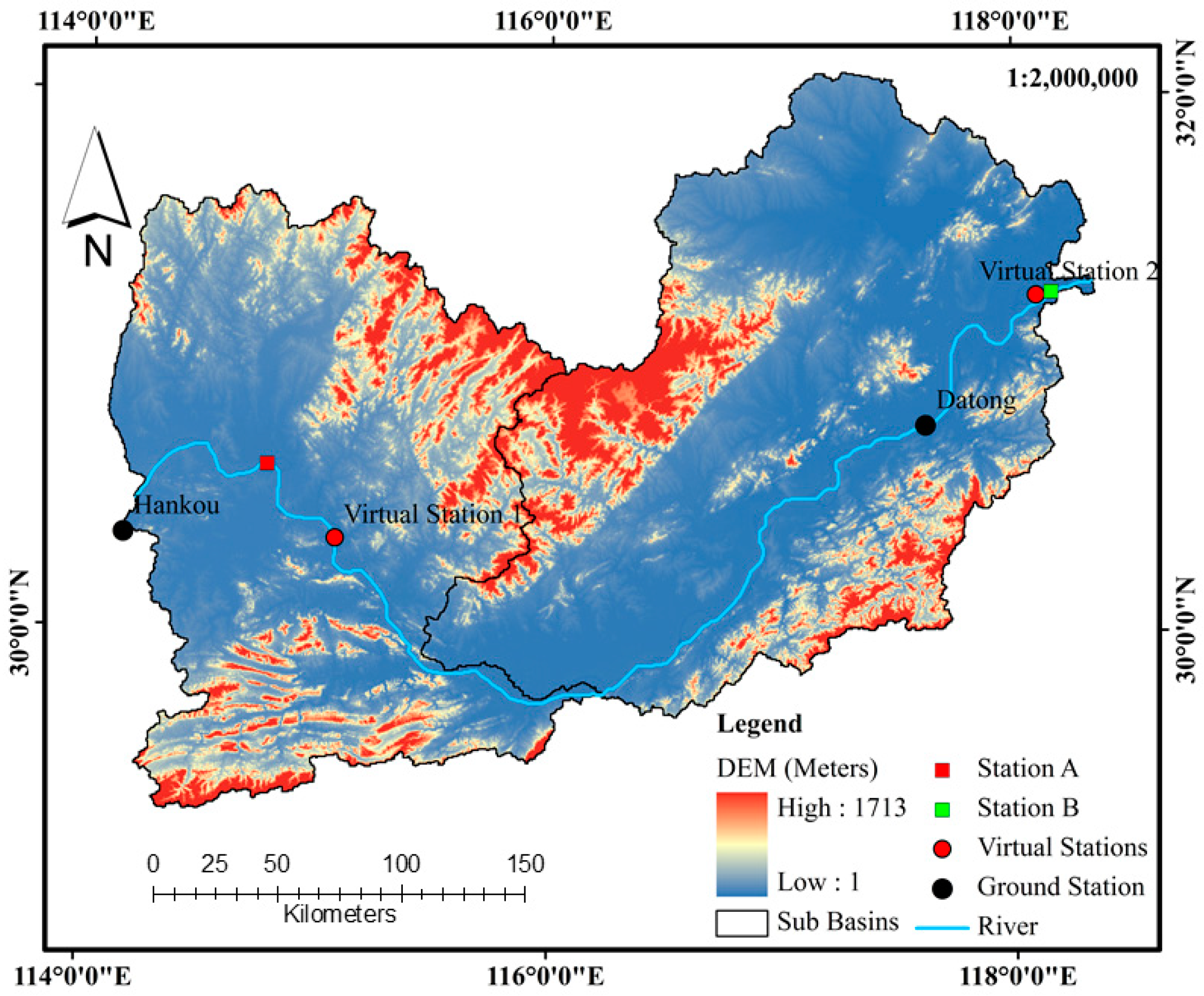
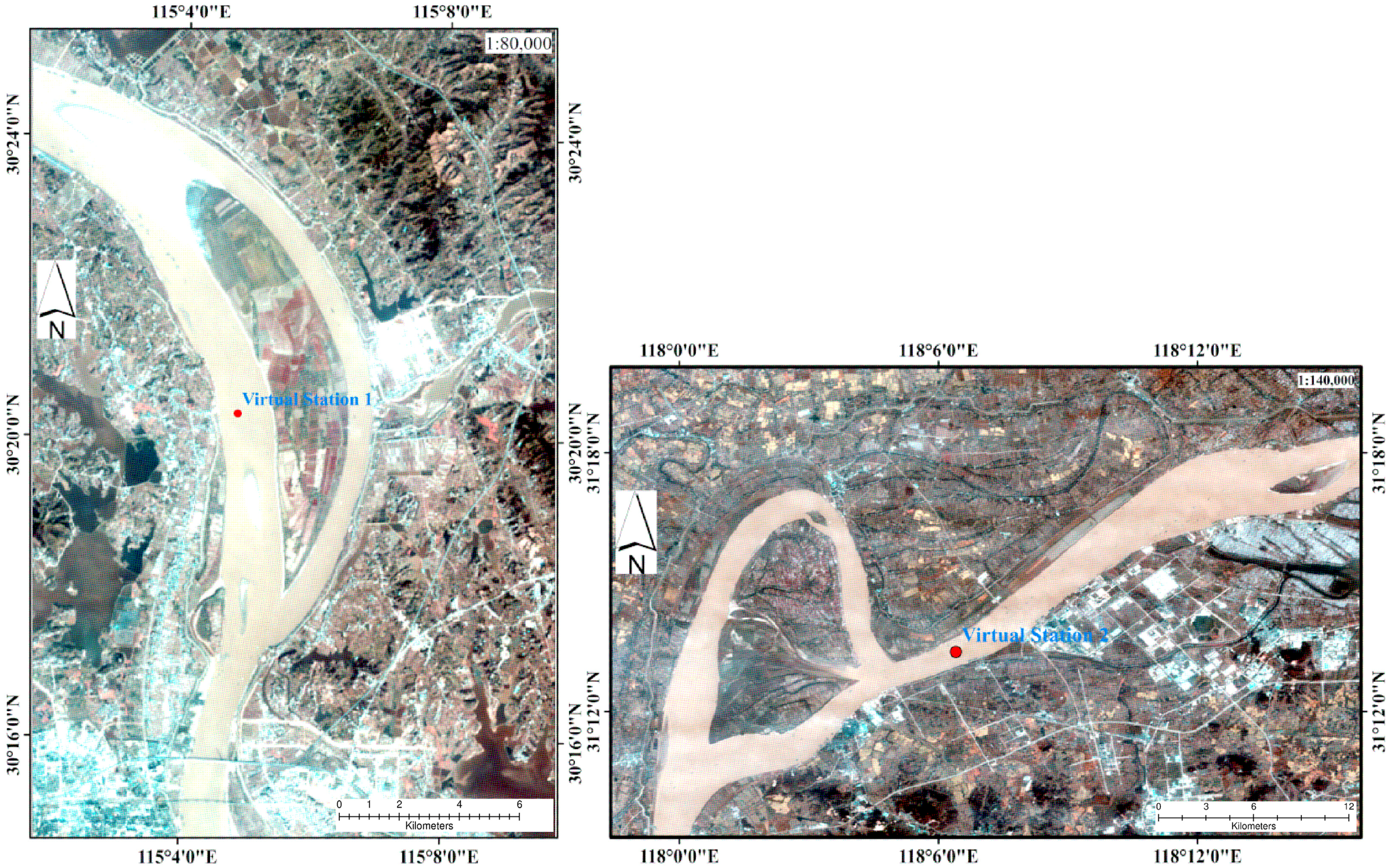

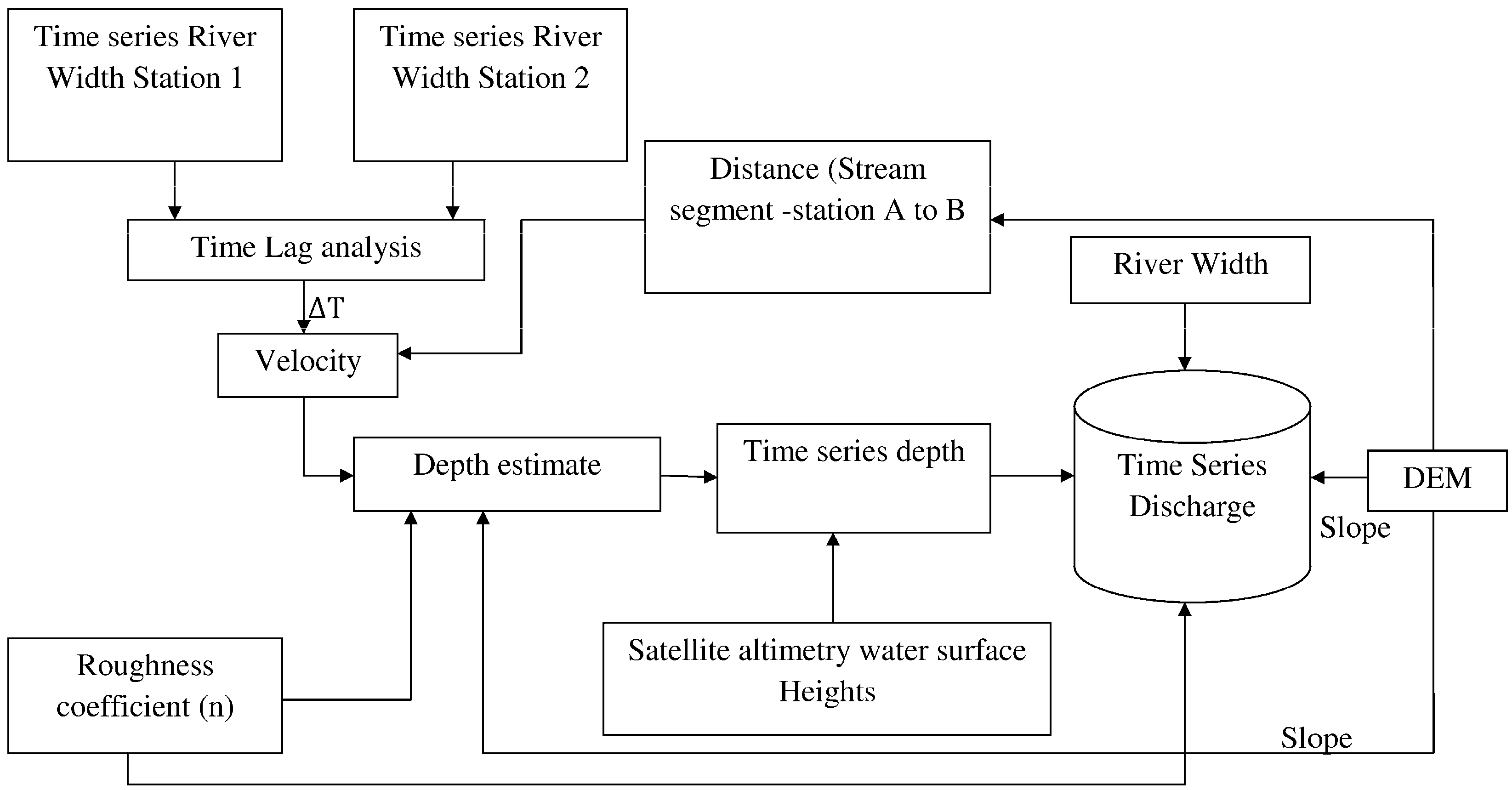
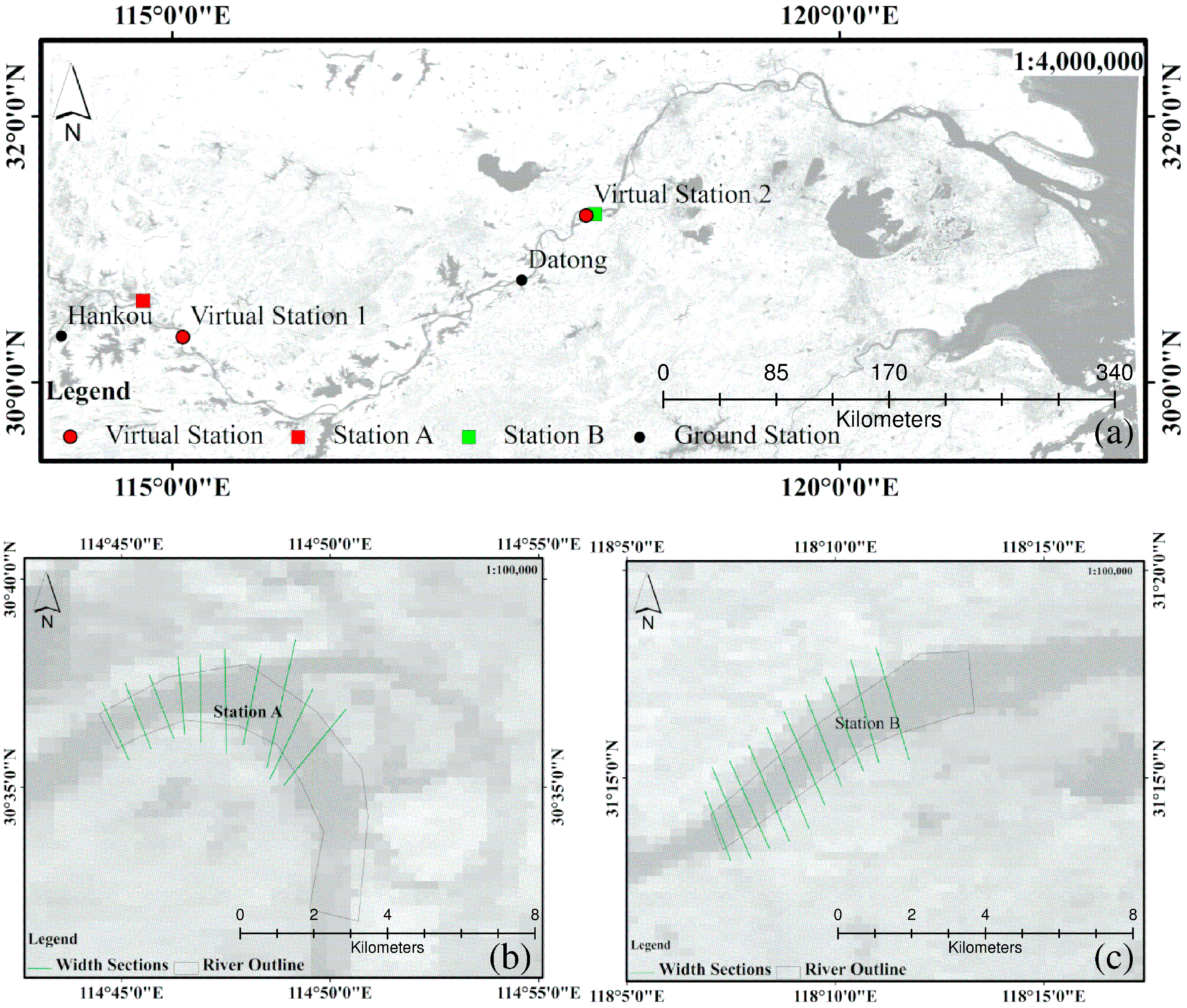
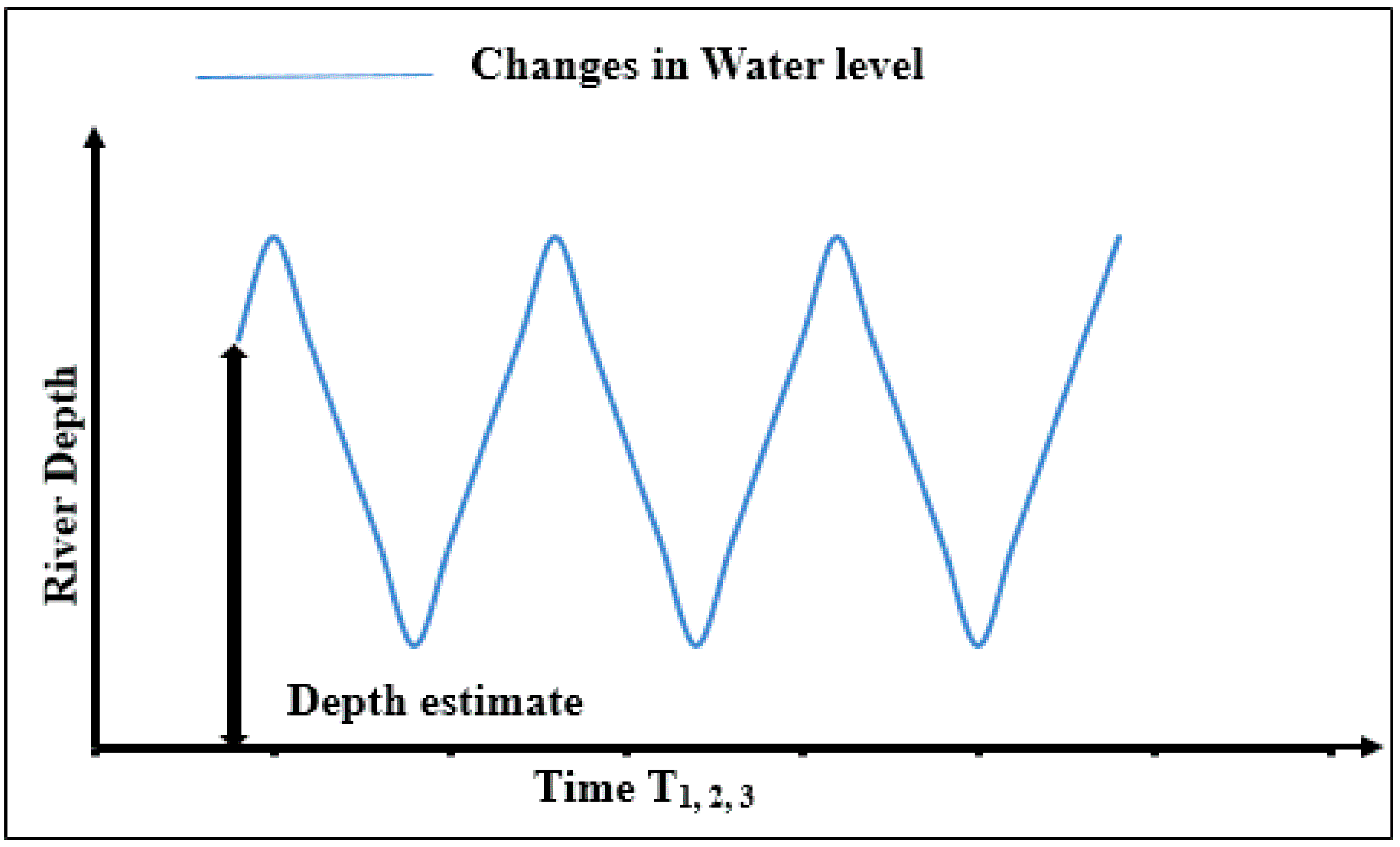
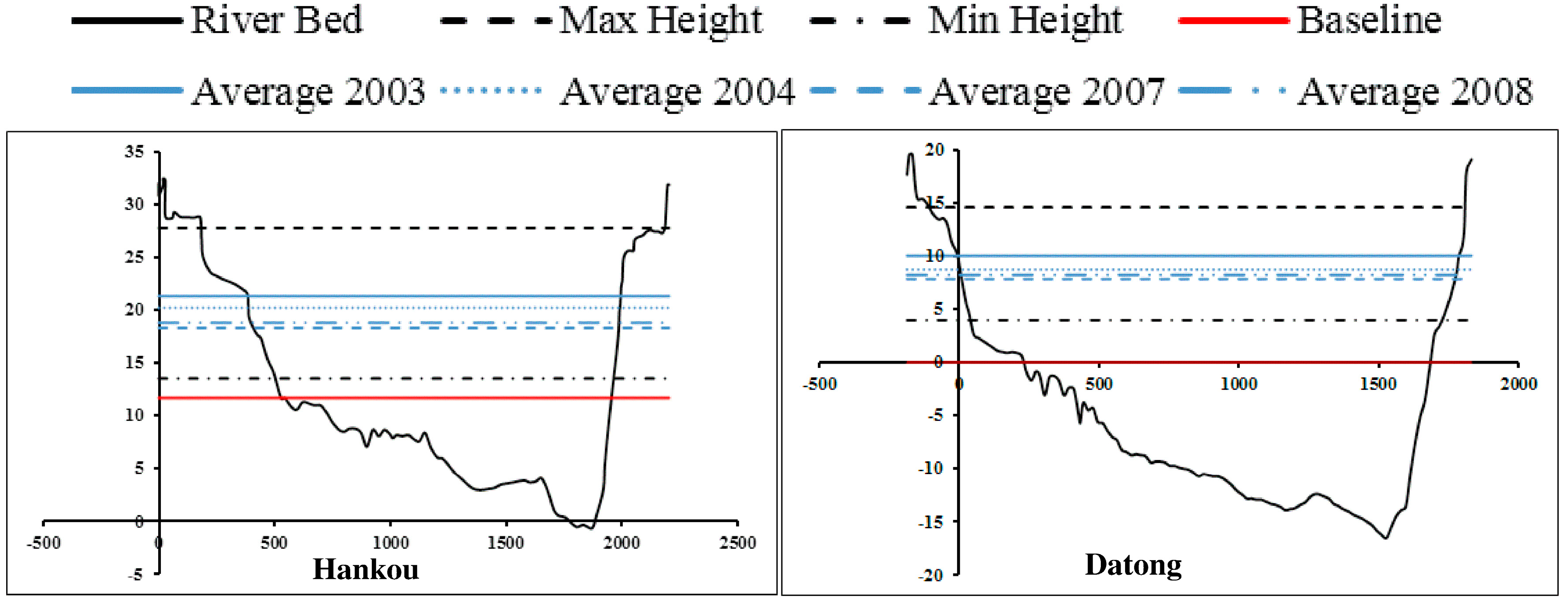
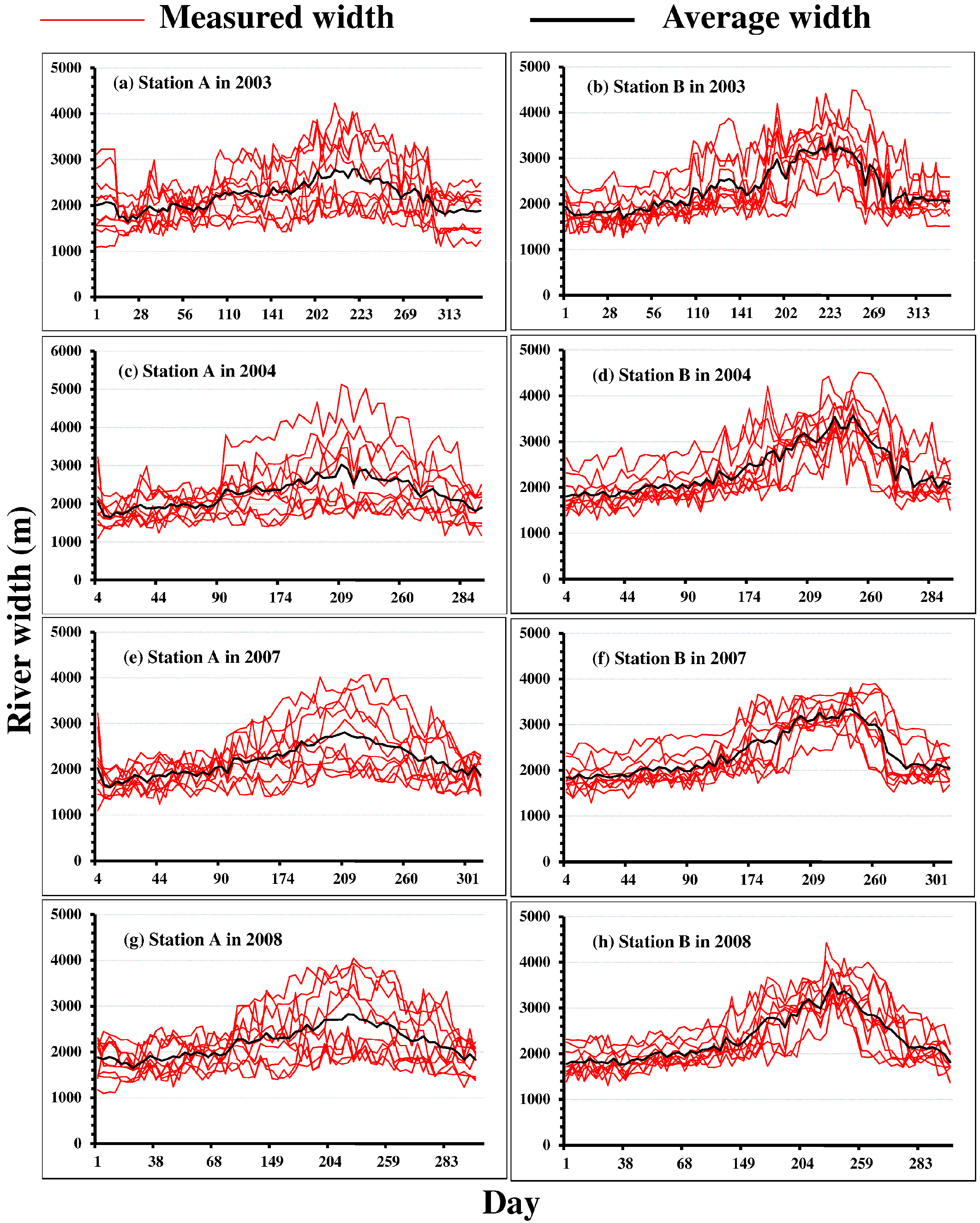
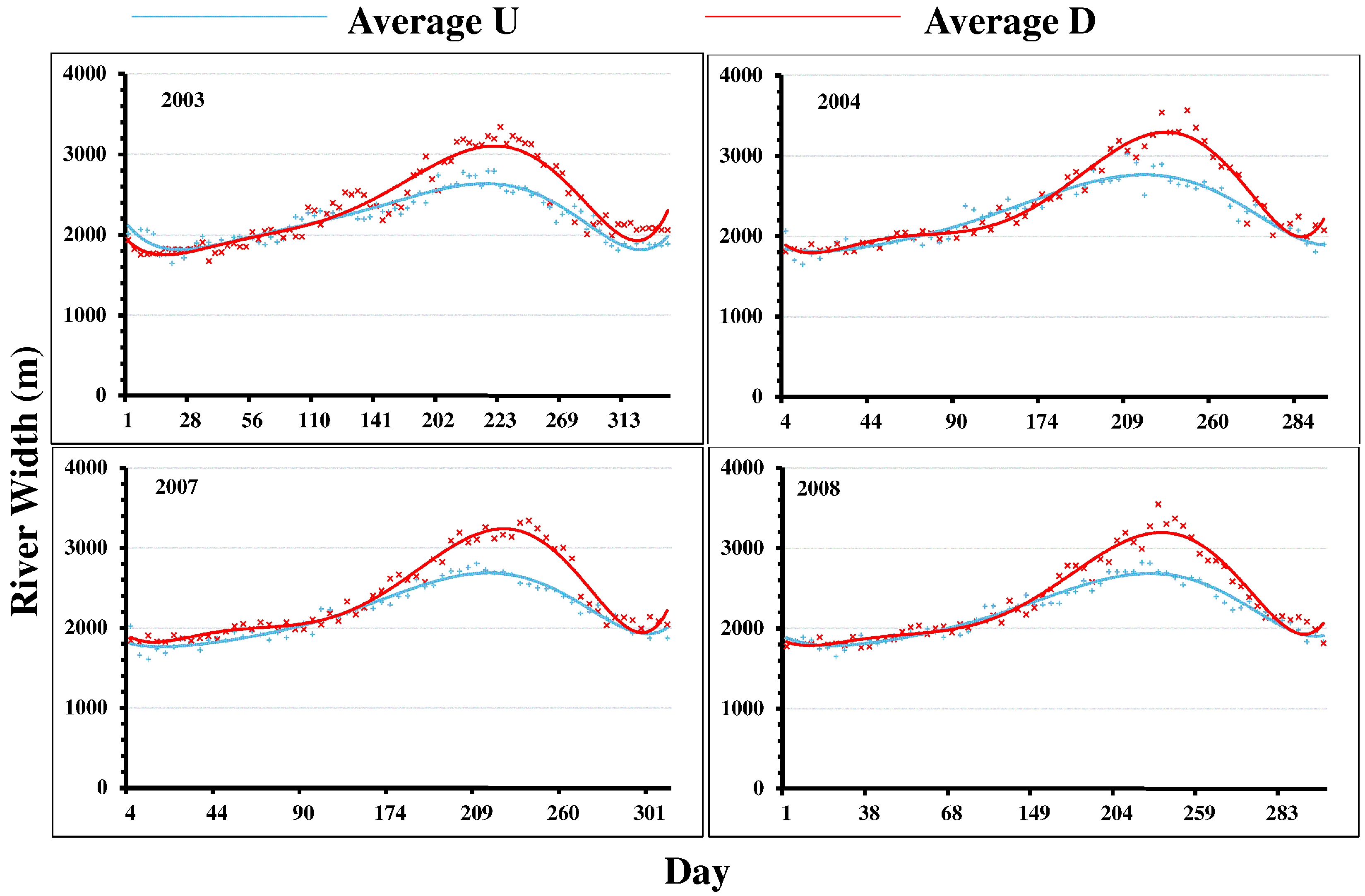

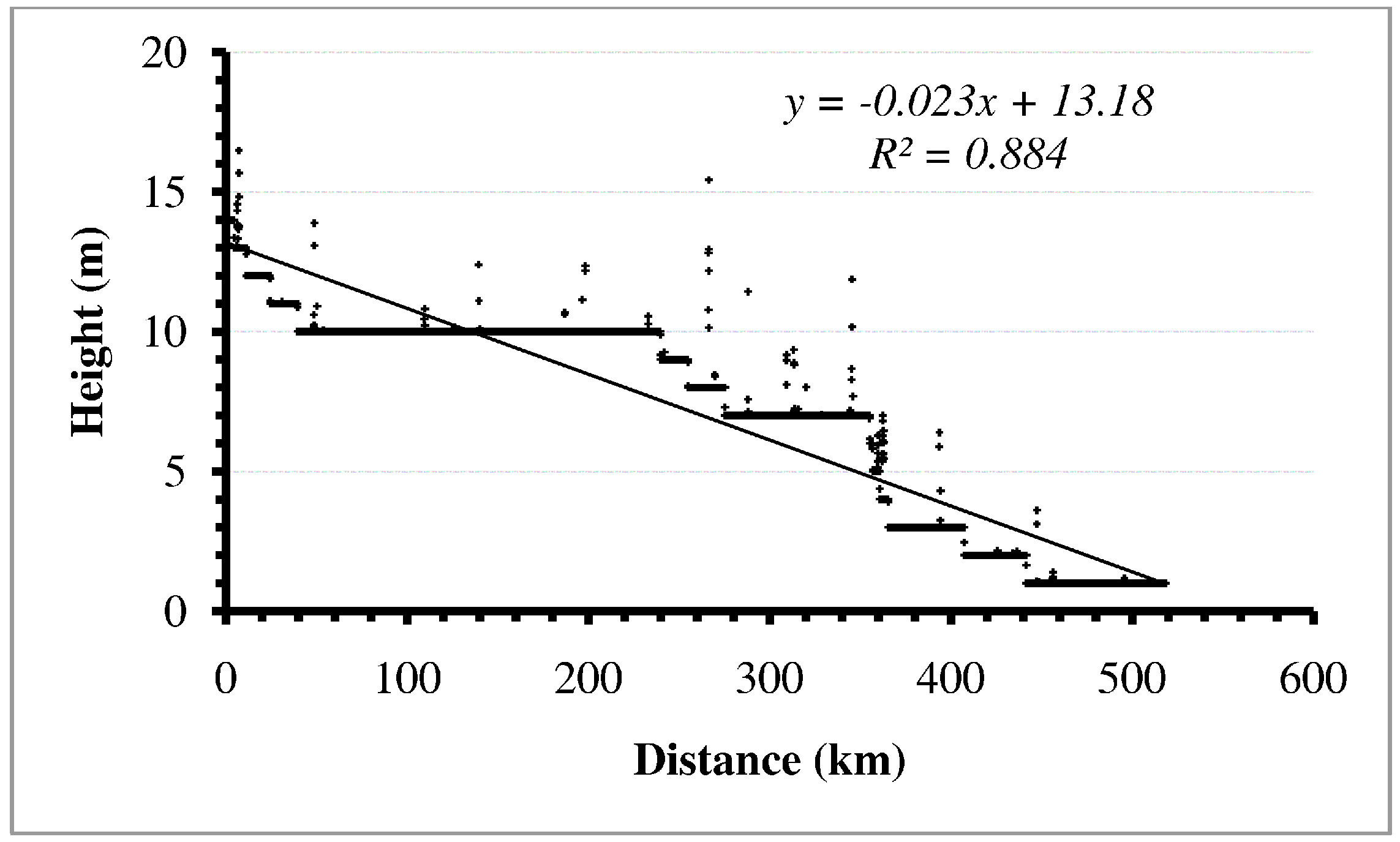


| Study | Data Used | Approach | Key Results |
|---|---|---|---|
| [7] | Landsat TM. | Landsat TM is used to approximate at-many-stations (AMHG). |
|
| [6] | Landsat TM. | Advances the AMHG discharge retrieval approach via additional parameter optimizations and validation on 34 gauged rivers spanning a diverse range of geomorphic and climatic settings. |
|
| [18] | Water levels, digital elevation model (DEM). | Proposes a data assimilation framework to reduce the error of water depth prediction in tributaries, update the streamflow prediction, and introduce a scope for updating the initial conditions of continental-scale hydrological models. |
|
| [3] | MODIS and multiple satellite altimetry. | River stage is incorporated with the effective river width. A comparison is made against a stage-derived discharge estimation equation and the empirical equation proposed by [19]. |
|
| [20] | MODIS MOD09Q1 and in situ discharge measurements. | A method that constructs the rating curve through the quantile functions of measured discharge and calculated river width is used. |
|
| [21] | The Surface Water and Ocean Topography (SWOT) measurements are modeled. | The estimated measurements are input into an algorithm to obtain estimates of river depth and discharge. |
|
| [22] | Jason-2, MODIS-derived inundation extent and water elevation and discharge data. | A hydrodynamic model is built using remotely-sensed inputs to augment traditional hydrological data for a series of linked reaches along a dryland anabranching river system. |
|
| [23] | Topographical maps, aerial photos, synthetic Aperture radar (SAR) images. | The hydraulic relationship is used to estimate in-bank river discharge using remotely sensed data [19]. |
|
| [24] | Forcing meteorological data from publicly available datasets and remotely sensed river width (SAR imagery). | A method calibrating hydrological models using river width derived from remote sensing is demonstrated. |
|
| [16] | Water levels derived from satellite altimetry at a basin outlet were used to calibrate the model. |
| |
| [25] | Along-track interferometric synthetic aperture radar InSAR, along track interferometric (ATI). | Surface velocity measurements from SAR were converted to depth-integrated velocity and then empirical models were applied to estimate discharge. |
|
| This study | MODIS, Landsat, satellite altimetry, Shuttle Radar Topographic Mission Digital Elevation Model (SRTM DEM). | Estimates river discharge exclusively using satellite-derived parameters. |
|
| Channel Conditions | Values | ||
|---|---|---|---|
| Material involved | Earth | n0 | 0.025 |
| Rock cut | 0.025 | ||
| Fine gravel | 0.024 | ||
| Course gravel | 0.027 | ||
| Degree of irregularity | Smooth | n1 | 0.000 |
| Minor | 0.005 | ||
| Moderate | 0.010 | ||
| Severe | 0.020 | ||
| Variation of channel cross-section | Gradual | n2 | 0.000 |
| Alternating occasionally | 0.005 | ||
| Alternating frequently | 0.010–0.015 | ||
| Relative effect of obstructions | Negligible | n3 | 0.000 |
| Minor | 0.010–0.015 | ||
| Appreciable | 0.020–0.030 | ||
| Severe | 0.040–0.060 | ||
| Vegetation | Low | n4 | 0.005–0.010 |
| Medium | 0.010–0.025 | ||
| High | 0.025–0.050 | ||
| Very High | 0.050–0.100 | ||
| Degree of meandering | Minor | n5 | 1.000 |
| Appreciable | 1.150 | ||
| Severe | 1.300 |
| NS (±) | RMSE (±m3/s) | RRMSE (±%) | RE (±%) | R2 | |
|---|---|---|---|---|---|
| Virtual station 1 | 0.50 | 7144.68 | 34.63 | 10.51 | 0.59 |
| Virtual station 2 | 0.76 | 5489.49 | 26.34 | 0.94 | 0.90 |
| NS (±) | RMSE (±m3/s) | RRMSE (±%) | RE (±%) | |
|---|---|---|---|---|
| Roughness coefficient | 0.11 | 744.63 | 3.76 | 6.91 |
| Slope | 0.07 | 503.3 | 2.45 | 4.71 |
| Width | 0.02 | 163.24 | 0.79 | 1.65 |
| NS (±) | RMSE (±m3/s) | RRMSE (±%) | RE (±%) | |
|---|---|---|---|---|
| Roughness coefficient | 0.04 | 952.36 | 1.99 | 4.40 |
| Slope | 0.03 | 788.51 | 1.27 | 2.58 |
| Width | 0.04 | 885.30 | 1.70 | 3.85 |
© 2018 by the authors. Licensee MDPI, Basel, Switzerland. This article is an open access article distributed under the terms and conditions of the Creative Commons Attribution (CC BY) license (http://creativecommons.org/licenses/by/4.0/).
Share and Cite
Sichangi, A.W.; Wang, L.; Hu, Z. Estimation of River Discharge Solely from Remote-Sensing Derived Data: An Initial Study Over the Yangtze River. Remote Sens. 2018, 10, 1385. https://doi.org/10.3390/rs10091385
Sichangi AW, Wang L, Hu Z. Estimation of River Discharge Solely from Remote-Sensing Derived Data: An Initial Study Over the Yangtze River. Remote Sensing. 2018; 10(9):1385. https://doi.org/10.3390/rs10091385
Chicago/Turabian StyleSichangi, Arthur W., Lei Wang, and Zhidan Hu. 2018. "Estimation of River Discharge Solely from Remote-Sensing Derived Data: An Initial Study Over the Yangtze River" Remote Sensing 10, no. 9: 1385. https://doi.org/10.3390/rs10091385
APA StyleSichangi, A. W., Wang, L., & Hu, Z. (2018). Estimation of River Discharge Solely from Remote-Sensing Derived Data: An Initial Study Over the Yangtze River. Remote Sensing, 10(9), 1385. https://doi.org/10.3390/rs10091385




